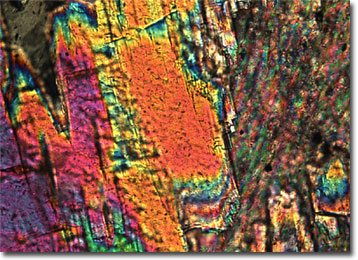Polarized Light Microscopy Digital Image Gallery
Actinolite Schist
Actinolite is an amphibole mineral abundant in the metamorphic rocks called schists that are easily divided into layers or flakes. The substance, which is typically formed during low-grade metamorphism of certain igneous or carbon-rich rocks, occurs in several different varieties.

One type of actinolite is known as nephrite, one of the two minerals commonly referred to as jade. Creamy white to green in color, nephrite is more common and less valuable than jadeite, the other form of jade, but, nevertheless, has a long history of ornamental and religious use in various countries, especially China. Large deposits of nephrite can be found in numerous locations throughout the world, including the Khotan and Yarkland regions in central Asia, the Lake Baikal vicinity of Siberia, and southern Wyoming and the Alaskan Jade Mountains in the United States.
Another kind of actinolite is composed of microscopic fibrous crystals and is known as byssolite. This substance is one of the minerals designated as asbestos, a material valued for its fire resistance for thousands of years. In modern times, asbestos has been utilized as an insulator, as a building material, and as a flame retardant. However, inhalation of asbestos fibers became associated with lung cancer in the 1970s and mounting evidence of its adverse effects on one’s health led to various restrictions on its use. Throughout the 1980s, scientists developed numerous alternatives to asbestos, which also facilitated the material's gradual decrease in usage. Today, the asbestos most people are exposed to is located in old houses and buildings, as well in the linings of automobile brakes and gaskets.
